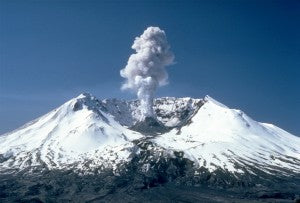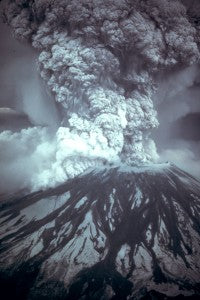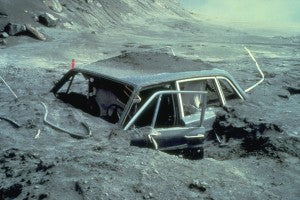The Force Volcano Awakens

Mount Saint Helens – the volcano that blew off 1,000 feet of the mountain and darkened the skies with its ash in 1980 – is reportedly ripe with earthquakes. According to reports from the
U.S. Geological Survey (USGS), there have been over 130 earthquake around Mount Saint Helens since March 14, 2016. That’s a lot of seismic activity!
Fortunately, most of the earthquakes have magnitudes of 0.5 or less. The strongest recorded quake in this time period was a magnitude 1.3. Even standing directly above these tiny tremors, we still wouldn’t be able to feel them.
These miniature earthquakes remind us that Mount Saint Helens is very much an
alive and active volcano. These tremors are caused by the magma recharging and entering the volcano’s chamber, putting stress on the earth’s crust. So it’s not the shifting of tectonic plates after all; it’s the gathering of magma.
Worried yet?
Don’t be. Well, not yet, at least. Before the 1980 eruption of Mount Saint Helens, there were over 10,000 earthquakes leading up to that event. The
USGS released a statement in that they believe “there is absolutely no sigh that it will erupt anytime soon.”
Basically, Mount Saint Helens is an active volcano, and an eruption will come. Scientists just don’t know when. They say it could be years – or decades – away.
The 1980 Eruption
[caption id="attachment_20528" align="alignright" width="200"]

Mount Saint Helens eruption, May 18, 1980 - Image courtesy of USGS[/caption]
On May 18, 1980, Mount Saint Helens blew off 1,000 feet of the mountain and,
according to Tech Times, “unleashed massive quantities of rock, ash and debris into the air.” The blast cause 150,000 acres of fir trees to become flattened, and “triggered one of the largest landslides ever witnessed in recorded history.”
About 540 million tons of ash was ejected into the sky during the nine hours of violent eruptions. Two days after the eruption, ash from the blast was found in the central United States. Within two weeks, ash from the eruption had made its way around the globe. Because of all the ash, crops in Eastern Washington had an estimated
$100 million in loss. Despite the losses, however, the ash was
at least somewhat beneficial in the long term, due to the trace elements and minerals contained in the ash that support plant growth.
Prepare for Eruption
Still, considering the power of the blast, it wasn’t as bad as it might have been. When Mount Saint Helens erupts again, however, there will still be problems, and being prepared is something we could all take seriously.
How does one prepare for a volcano eruption, you ask?
[caption id="attachment_20529" align="alignright" width="300"]

Photographer Reid Blackburn's car after the eruption.[/caption]
Well, just like any disaster, you will want at least a 72 hour kit. This kit should have clean water, food, gear for warmth and sanitation, and other necessities that can keep you supported and safe for three or more days. Directly following a disaster, power could be out, water could be contaminated, and food could be scarce. As we saw from the 1980 eruption, millions of dollars’ worth of food was lost. Likewise, many roads were closed and flights were cancelled due to dangerously low visibility. These conditions could affect your local markets, making it harder to get food. That’s why having an
emergency supply of food and water is always a good idea.
Mount Saint Helens is active, and it’s setting off lots of little earthquakes underneath the ground. While it could still be decades before we have to worry about it blowing its top (again), the key to staying safe is by being prepared, and the way to be prepared is to start today.
No matter what major event you’re preparing for, you can use that prep for anything. And by being prepared in advance, you can save yourself a lot of discomfort in the future.

 Mount Saint Helens – the volcano that blew off 1,000 feet of the mountain and darkened the skies with its ash in 1980 – is reportedly ripe with earthquakes. According to reports from the U.S. Geological Survey (USGS), there have been over 130 earthquake around Mount Saint Helens since March 14, 2016. That’s a lot of seismic activity!
Fortunately, most of the earthquakes have magnitudes of 0.5 or less. The strongest recorded quake in this time period was a magnitude 1.3. Even standing directly above these tiny tremors, we still wouldn’t be able to feel them.
These miniature earthquakes remind us that Mount Saint Helens is very much an alive and active volcano. These tremors are caused by the magma recharging and entering the volcano’s chamber, putting stress on the earth’s crust. So it’s not the shifting of tectonic plates after all; it’s the gathering of magma.
Worried yet?
Don’t be. Well, not yet, at least. Before the 1980 eruption of Mount Saint Helens, there were over 10,000 earthquakes leading up to that event. The USGS released a statement in that they believe “there is absolutely no sigh that it will erupt anytime soon.”
Basically, Mount Saint Helens is an active volcano, and an eruption will come. Scientists just don’t know when. They say it could be years – or decades – away.
The 1980 Eruption
[caption id="attachment_20528" align="alignright" width="200"]
Mount Saint Helens – the volcano that blew off 1,000 feet of the mountain and darkened the skies with its ash in 1980 – is reportedly ripe with earthquakes. According to reports from the U.S. Geological Survey (USGS), there have been over 130 earthquake around Mount Saint Helens since March 14, 2016. That’s a lot of seismic activity!
Fortunately, most of the earthquakes have magnitudes of 0.5 or less. The strongest recorded quake in this time period was a magnitude 1.3. Even standing directly above these tiny tremors, we still wouldn’t be able to feel them.
These miniature earthquakes remind us that Mount Saint Helens is very much an alive and active volcano. These tremors are caused by the magma recharging and entering the volcano’s chamber, putting stress on the earth’s crust. So it’s not the shifting of tectonic plates after all; it’s the gathering of magma.
Worried yet?
Don’t be. Well, not yet, at least. Before the 1980 eruption of Mount Saint Helens, there were over 10,000 earthquakes leading up to that event. The USGS released a statement in that they believe “there is absolutely no sigh that it will erupt anytime soon.”
Basically, Mount Saint Helens is an active volcano, and an eruption will come. Scientists just don’t know when. They say it could be years – or decades – away.
The 1980 Eruption
[caption id="attachment_20528" align="alignright" width="200"] Mount Saint Helens eruption, May 18, 1980 - Image courtesy of USGS[/caption]
On May 18, 1980, Mount Saint Helens blew off 1,000 feet of the mountain and, according to Tech Times, “unleashed massive quantities of rock, ash and debris into the air.” The blast cause 150,000 acres of fir trees to become flattened, and “triggered one of the largest landslides ever witnessed in recorded history.”
About 540 million tons of ash was ejected into the sky during the nine hours of violent eruptions. Two days after the eruption, ash from the blast was found in the central United States. Within two weeks, ash from the eruption had made its way around the globe. Because of all the ash, crops in Eastern Washington had an estimated $100 million in loss. Despite the losses, however, the ash was at least somewhat beneficial in the long term, due to the trace elements and minerals contained in the ash that support plant growth.
Prepare for Eruption
Still, considering the power of the blast, it wasn’t as bad as it might have been. When Mount Saint Helens erupts again, however, there will still be problems, and being prepared is something we could all take seriously.
How does one prepare for a volcano eruption, you ask?
[caption id="attachment_20529" align="alignright" width="300"]
Mount Saint Helens eruption, May 18, 1980 - Image courtesy of USGS[/caption]
On May 18, 1980, Mount Saint Helens blew off 1,000 feet of the mountain and, according to Tech Times, “unleashed massive quantities of rock, ash and debris into the air.” The blast cause 150,000 acres of fir trees to become flattened, and “triggered one of the largest landslides ever witnessed in recorded history.”
About 540 million tons of ash was ejected into the sky during the nine hours of violent eruptions. Two days after the eruption, ash from the blast was found in the central United States. Within two weeks, ash from the eruption had made its way around the globe. Because of all the ash, crops in Eastern Washington had an estimated $100 million in loss. Despite the losses, however, the ash was at least somewhat beneficial in the long term, due to the trace elements and minerals contained in the ash that support plant growth.
Prepare for Eruption
Still, considering the power of the blast, it wasn’t as bad as it might have been. When Mount Saint Helens erupts again, however, there will still be problems, and being prepared is something we could all take seriously.
How does one prepare for a volcano eruption, you ask?
[caption id="attachment_20529" align="alignright" width="300"] Photographer Reid Blackburn's car after the eruption.[/caption]
Well, just like any disaster, you will want at least a 72 hour kit. This kit should have clean water, food, gear for warmth and sanitation, and other necessities that can keep you supported and safe for three or more days. Directly following a disaster, power could be out, water could be contaminated, and food could be scarce. As we saw from the 1980 eruption, millions of dollars’ worth of food was lost. Likewise, many roads were closed and flights were cancelled due to dangerously low visibility. These conditions could affect your local markets, making it harder to get food. That’s why having an emergency supply of food and water is always a good idea.
Mount Saint Helens is active, and it’s setting off lots of little earthquakes underneath the ground. While it could still be decades before we have to worry about it blowing its top (again), the key to staying safe is by being prepared, and the way to be prepared is to start today.
No matter what major event you’re preparing for, you can use that prep for anything. And by being prepared in advance, you can save yourself a lot of discomfort in the future.
Photographer Reid Blackburn's car after the eruption.[/caption]
Well, just like any disaster, you will want at least a 72 hour kit. This kit should have clean water, food, gear for warmth and sanitation, and other necessities that can keep you supported and safe for three or more days. Directly following a disaster, power could be out, water could be contaminated, and food could be scarce. As we saw from the 1980 eruption, millions of dollars’ worth of food was lost. Likewise, many roads were closed and flights were cancelled due to dangerously low visibility. These conditions could affect your local markets, making it harder to get food. That’s why having an emergency supply of food and water is always a good idea.
Mount Saint Helens is active, and it’s setting off lots of little earthquakes underneath the ground. While it could still be decades before we have to worry about it blowing its top (again), the key to staying safe is by being prepared, and the way to be prepared is to start today.
No matter what major event you’re preparing for, you can use that prep for anything. And by being prepared in advance, you can save yourself a lot of discomfort in the future.



1 comment
PurpleButterflygarden
I think you are referring to lava when you say magma. Magma has never been seen by man, only lava has, and that is what erupts from a volcano. Lava is unique to the volcano it issues from because it is melted rock from below the volcano. There is no scientific proof that magma exists. Earthquakes are formed due to friction along fault lines and the daily earth tides that cause the land masses to rise and fall daily. Pressure builds until it is released as major earthquakes and lava is formed. We definitely do need to be prepared! Keep up the good work assisting us in that effort.